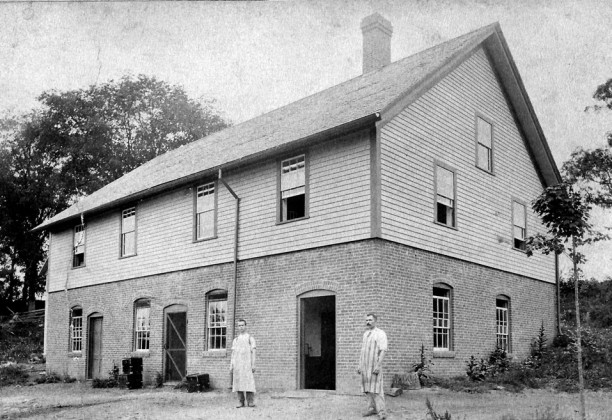Started in 1886 by town residents, the Andover Creamery Corporation typified cooperative agricultural enterprises of the late 19th and early 20th centuries. In contrast to the usual system where local farmers produced their own butter on individual farms, the Andover Creamery Corporation allowed small producers to make butter more efficiently and distribute their product to a broader consumer base by combining their resources. Not only did this arrangement bring Andover farmers greater profits, it also helped them produce an award-winning product.
Butter-making: From Cottage Industry to Collective Enterprise
In early America, butter-making usually fell within the scope of “women’s work” inside the home. Women made butter for their families, and any excess product found its way to local markets. By the mid-1800s, butter-making became a male-dominated industry in which farming enterprises produced large quantities of product meant specifically for sale in the market. Slowly, northern dairy farmers mechanized their processes to increase profits and phased out crops that did not directly support dairy production.
In Andover, cooperative butter production began in earnest in 1887. Local farmers brought their cream to one central location, the Andover Creamery Corporation. There, a seven-horsepower steam engine drove large motorized rotary churns that more efficiently separated the milkfat (which becomes butter) from the cream. To help boost production, the Andover Creamery even hired gatherers to venture out into the country and bring back cream to the center.
In contrast to the hundreds of pounds of butter per year that the average farmer produced during this time, the Andover Creamery Corporation produced hundreds of pounds of butter per day. The creamery then took advantage of local rail contracts to ship their product across the country. This national exposure helped the Andover Creamery’s butter win a bronze medal at the 1893 World’s Columbian Exhibition in Chicago.
By the start of the 20th century, the Andover Creamery Corporation produced almost 100,000 pounds of butter per year but had begun to feel the pressure of competition from large commercial milk producers. Thanks to greater access to feed and raw materials, as well as the power to negotiate favorable rates for rail transportation, farmers in the Midwest began delivering dairy products to the East Coast at prices cheaper than most eastern dairy producers offered. In 1915, Andover Creamery Corporation owners voted to dissolve their enterprise and sell its property. For years afterward, the creamery’s facilities served as a general store and gas station and, later, as an apartment building before being torn down in June of 2002.








